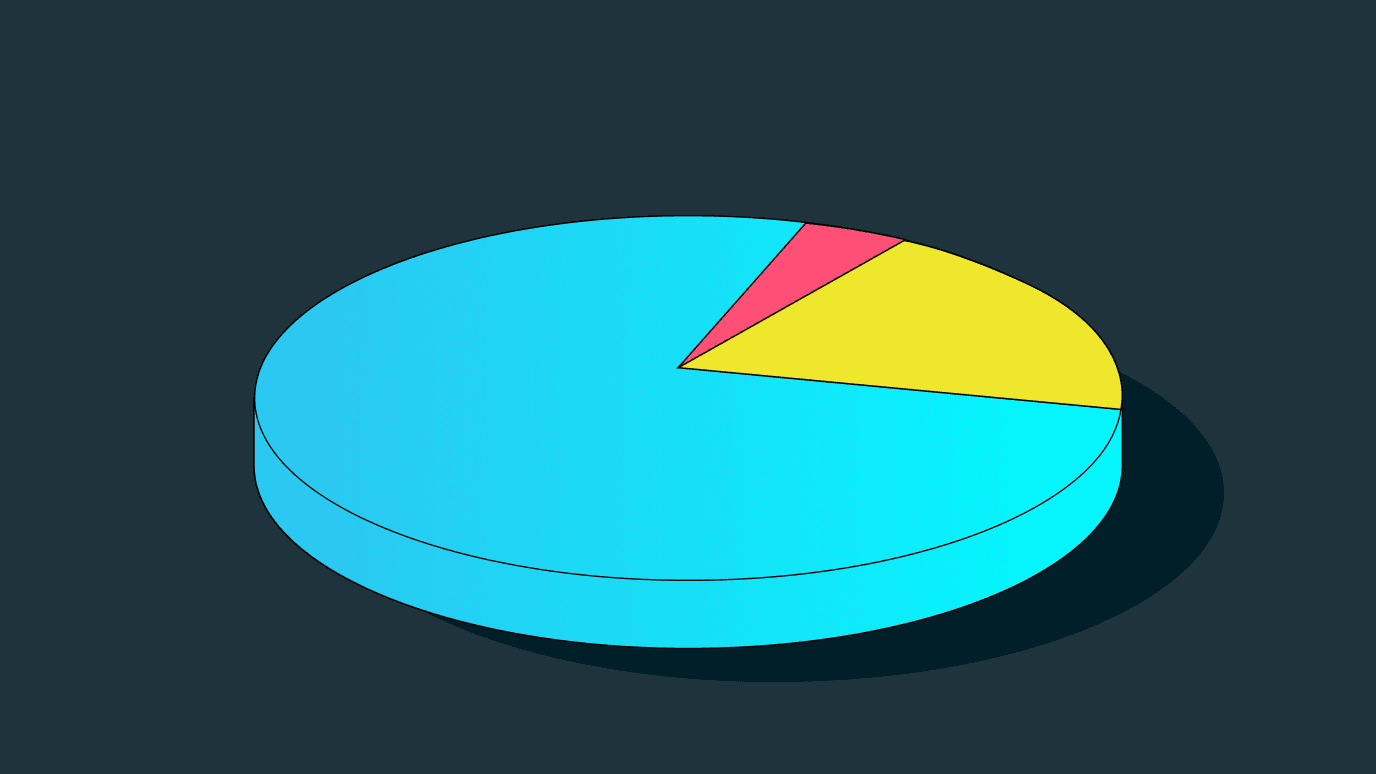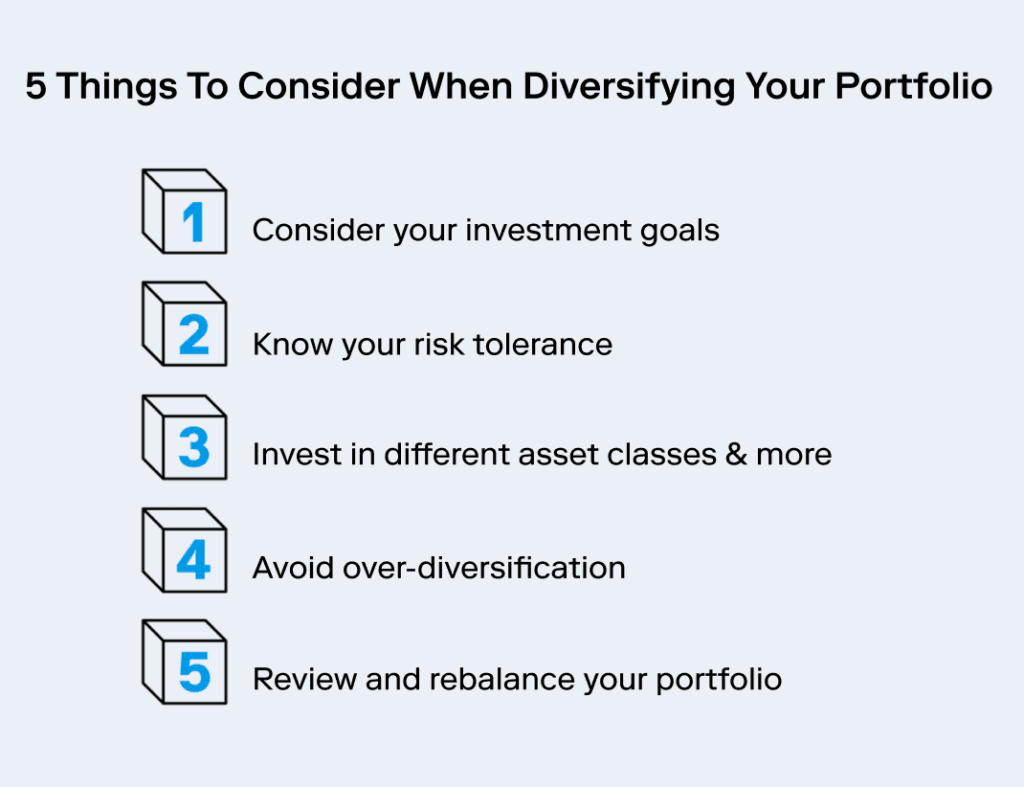Apr 18, 2023
What Is Diversification? A Guide to Protecting Your Portfolio

Diversification is an investment strategy that spreads the holdings in your investment portfolio across different asset classes to reduce overall risk. In other words, diversification follows the old adage “don’t put all your eggs in one basket.” If you drop the basket, you risk losing all of your eggs at once. Putting all of your money into just one stock, or even a narrow selection of stocks, bonds, or funds, can be risky for the same reason. Market fluctuations are inevitable, but a diversified portfolio can provide a cushion: if one of your specific investments loses value, others may hold steady or even grow. That can mean more protection against volatility in the market.
The importance of diversification
Many new investors focus only on how to buy stocks, but that narrow view can miss an important way to reduce risk. Diversification in investing means spreading your money across asset classes rather than putting it all into just one type of investment. That helps protect your portfolio because various asset classes, like stocks, bonds, and funds, have different levels of risk and volatility, and they can even behave differently when market conditions change.
For example, say you decide to invest $300, and you put it all toward stock in Company X. If the share price then drops by 60%, your portfolio would be worth $120. That’s a pretty painful loss.
If you were to spread your $300 investment across three different types of assets rather than one specific investment, you could cushion that blow. Consider this example of diversification: suppose you spread your $300 across three asset classes: $100 in Company X’s stock, $100 in a bond, and $100 in an exchange-traded fund (ETF). Imagine the following happens next:
Company X’s stock drops by 60%. Your investment is now worth $40
The value of the bond stays the same. Your investment is still worth $100
The value of the ETF shares increase by 30%. Your investment is now worth $130
In this scenario, your total portfolio would now be worth $270. You’d have lost some value in your stocks, but gained a bit through your ETF. That stings a lot less. This simple example displays how asset allocation, or selecting a variety of asset classes for your portfolio, can reduce risk to your portfolio when one type of investment loses value.
Benefits of diversification:
Reduce investment risk: Spreading your investments around can smooth out the big dips and spikes in the market.
Increased returns: Some assets will perform well one year, while others do poorly. The next year their positions may reverse. Over the long term, these fluctuations tend to balance out to maximize your returns with minimized risk.
Exposure to different markets: Investing across industries, sectors, geographic regions, and asset classes allows you to leverage the ups and downs of different markets. When one is underperforming, another can make up the difference.
Support for both short- and long-term goals: Different time horizons require different types of investments. Portfolio diversification allows you to both plan for retirement and realize shorter-term goals like putting a down payment on a home or buying a new car.
Know that diversification doesn’t cut out all risk
There is no such thing as risk-free investing. So while the purpose of diversification is to reduce your overall risk as an investor, your portfolio will still be subject to both overall market and asset-specific risks, also known as systematic and unsystematic risk.
Systematic risk: This type of risk is tied to the broader market, and it’s inherent to any type of investing. Systematic risks, also known as volatility risks, include inflation, recessions, interest rate fluctuations, natural disasters, and geopolitical conflict. Even when you keep your eyes on the market, it’s impossible to anticipate every type of systemic risk, and different asset classes may behave differently in reaction to the same situation.
Unsystematic risk: This type of risk, also known as company-specific risk, is tied to investment in a specific industry or company. Unsystematic risks are categorized as Business, Operational, Financial, Legal and Regulatory, and Strategic. Specific risks that may fall into these categories include a shift in company management, a strike, a regulatory change that could affect sales, a new competitor poised to take significant market share, or a product recall.
Types of diversification
The benefits of diversification may be clear, but exactly how do you diversify your investments? Simply buying lots of different securities doesn’t necessarily create a well-balanced portfolio. You’ll want to understand three types of diversification:
Diversifying by asset classes
There are a number of different asset classes to choose from. The asset allocation that works for you depends on your risk tolerance, time horizon, current financial situation, and future financial goals. Lower-risk assets like bonds tend to be more stable, meaning they’re less likely to fluctuate in value, but the returns may be lower over the long term. Higher-risk assets like stocks tend to be more volatile, meaning their value can go up and down rapidly; the trade-off is that they might produce greater returns. A diversified portfolio generally contains several asset classes of varying risk levels. Common asset types include stocks, bonds, various kinds of funds, and cash.
Stocks (equities): Stocks are securities that represent a unit of ownership in a company. Investors choose stocks based on the growth potential of the company; if the company does well, the stock value will usually grow too. Higher risk.
Bonds (fixed income): A bond is a debt security, similar to an IOU. When you invest in bonds, you’re lending to the issuer, which may be a government, municipality, or corporation. The issuer promises to pay you back with interest, providing a reliable stream of fixed income. Lower risk.ETFs: An ETF is a diversified basket of securities like stocks, bonds, and commodities, similar to a mutual fund. The difference is that ETFs can be traded whenever the market is open. Generally lower-risk, but it can vary significantly among funds.
Mutual funds: Like an ETF, a mutual fund is a collection of investments, and you benefit from the built-in diversification of the fund’s portfolio. They’re usually more actively managed than ETFs and may have higher fees. Generally lower-risk, but it can vary significantly among funds.
Index funds: This type of investment, which may be a mutual fund or an ETF, is built to mirror the performance of a specific market index, such as the S&P 500 or the Dow Jones. An index fund that matches a major stock index should reflect the diversity and historic growth of that index. Lower risk.
Cash (or cash equivalents): This refers to cash or any assets that can be readily converted to cash, like coins, currency, funds in checking/savings accounts, money market funds, or treasury bills. High liquidity, lower risk.
Diversifying by industry and sector
Spreading your money across industries and sectors can reduce risk, as performance can vary significantly among them. The U.S. stock market contains 11 different sectors:
Information technology
Healthcare
Financials
Consumer discretionary
Communication services
Industrials
Consumer staples
Energy
Utilities
Real estate
Materials
Diversification across sectors, and even across different industries in each sector, may be a useful strategy because factors that impact the performance of one sector might not cause issues for others. For example, the demand for new cars is likely to decrease during a recession, reducing the value of investments in the automotive industry, which is part of the consumer discretionary sector. At the same time, the need for healthcare usually remains steady even in tough economic times, so investments in that sector may hold their value in a bear market.
Diversifying by location
When building a diversified portfolio, you don’t have to limit yourself to U.S. securities. It’s possible to invest in Europe, Asia, South America, and beyond. One of the simplest ways to achieve global diversification is by purchasing shares in an ETF or mutual fund that gives you exposure to overseas securities. Keeping your investments geographically diverse can help spread your risk. Even if economies in one region contract, others may grow.
Things to consider when diversifying your portfolio
Your investment choices are personal, reflecting your goals and values. That means your approach to asset allocation will be personal as well. So what is diversification going to look like in your portfolio? Keep these five ideas in mind as you explore your options:

1. Consider your investment goals
Are you aiming for long-term gains to fund a retirement nest egg or a young child’s college education, or do you have shorter-term goals? Your time horizon can help you determine if your asset allocation should be more heavily weighted toward investments that tend to build wealth over time or if you’re willing to take a bit more risk for potential earlier rewards.
2. Know your risk tolerance
Everyone’s comfort level is different when it comes to taking risks with money. Aggressive investors are willing to take greater risks in the hope of greater returns. Moderate investors want to grow their money without losing too much, so they take a balanced approach. Conservative investors prioritize the least amount of volatility possible, even if the returns are slightly lower. Factors that can influence your risk tolerance include your amount of discretionary income, how soon you’re counting on your investments to grow, and whether uncertainty tends to cause you anxiety in general.
3. Invest in different asset classes and more
A mix of stocks, bonds, funds, and other assets leads to a more diversified portfolio. But diversification doesn’t have to stop there; look for different varieties of investments within each asset class. For example, you might want to ensure the money you put into stocks is allocated across many different sectors; you might even diversify your holdings within each sector among multiple industries.
4. Avoid over-diversification
If a diversified portfolio can help reduce risk, over-diversification may seem counterintuitive. But there can be too much of a good thing. Over-diversification can water down your portfolio with too many different investments, creating inefficiency without adding more benefits. And that may cause you to forego gains or pay too much in fees. If you’re holding assets you don’t understand, more individual stocks than you can keep track of, or several funds in the same categories, you might be over-diversified.
5. Review and rebalance your portfolio
The market is always changing, so a well-diversified portfolio today may drift away from your ideal asset allocation later. Say you created a portfolio with 70% stocks and 30% bonds. As the value of those assets changes over time, you might wind up with a different percentage of your money in those asset classes. Periodically review your portfolio’s asset allocation and, if it no longer reflects your goals, decide which assets to buy, sell, or hold to bring it back on target. Many robo-advisors can automatically rebalance your portfolio, making it easy to stay on track.
Diversification: protecting your nest eggs with multiple baskets
As you move forward with your financial goals, diversification can help you strike the right balance between risk and possible rewards. Building a diversified portfolio, along with investing regularly and investing for the long term, is a core component of the Stash Way, our investment philosophy focused on building wealth over time.
Knowing the answer to “What is diversification?” is a first step; the next is applying what you’ve learned to your investment decisions. Whether you’re brand new to investing or are looking to improve your investment strategy, diversification can help you protect your investments for long-term success.
Related articles

investing
Dec 11, 2025
How to Invest through the Holidays—Without the Stress

investing
Oct 23, 2025
Why Millions Are Canceling Disney+ and Hulu and What It Means for Investors

investing
Aug 15, 2025
Money Insights

investing
Jul 07, 2025
How to start investing: a guide for beginners

investing
Jun 04, 2025
Growth Stocks to Invest in for 2025

investing
Jun 03, 2025
Sustainable Investing Stocks to go after in 2025
By using this website you agree to our Terms of Use and Privacy Policy. To begin investing on Stash, you must be approved from an account verification perspective and open a brokerage account.

